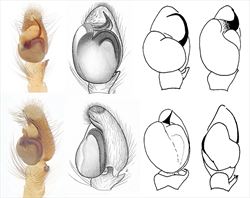
Examples of live Holoplatys
Illustrator (and ©) I.R. Macaulay

Aspects of the general morphology of Holoplatys
Illustrators (and ©) B.J. Richardson (CSIRO, )M. Zabka (diag.) (AMS)

alp morphology of Holoplatys
Illustrators (and ©) B.J. Richardson (CSIRO), M. Zabka (diag.) (AMS)

Epigyne morphology of Holoplatys
Illustrators (and ©) B.J. Richardson (CSIRO), M. Zabka (diag.) (AMS)
Holoplatys Simon, 1885
Taxonomy
Holoplatys has thirty-seven Australian species: Holoplatys bicolor, H. bicoloroides, H. borali, H. braemarensis, H. bramptonensis, H. canberra, H. chudalupensis, H. colemani, H. complanata, H. complanatiformes, H. daviesae, H. dejongi, H. desertina, H. embolica, H. fusca, H. grassalis, H. invenusta, H. jardinensis, H. julimarina, H. kalgoorlie, H. kempensis, H. lhotskyi, H. liturata, H. mascordi, H. meda, H. minuta, H. oakensis, H. panthera, H. pedder, H. pemberton, H. planissima, H. queenslandica, H. rainbowi, H. semiplanata, H. strzeleckii. H. tasmaniensis and H. windjanensis. The genus is part of an Australasian clade (Maddison et al 2008) including Abracadabrella, Apricia, Clynotis, Huntiglennia, Ocrisiona, Opisthoncus, Paraphilaeus, Paraplatoides, Pungalina, Tara, Trite and Zebraplatys (Maddison 2015). Further information on the genus and described species can be found in Richardson and Żabka (2017) and Whyte and Anderson (2017).
Description
Holoplatys spp. are small to large-sized spiders, body length 3 to 11 mm, with a significantly flattened, elongate body. The thoracic part of the cephalothorax is much longer than the cephalic part and the fovea is displaced backwards to about halfway between the posterior lateral eyes and the back of the cephalothorax. There is a pair of small depressions between the posterior lateral eyes. The small chelicerae have either one (unident) tooth or none. The cephalothorax is widest well behind the lateral eyes. The chelicerae are tucked well behind the front of the animal and there is effectively no clypeus. The first leg is long and very strongly built. Usually there are no spines on the tibiae and metatarsi of legs one and two.
The male’s palp varies between species, sometimes with the embolus long and slender, sometimes short and thick. The embolus usually arises from the distal edge of the tegulum and forms a partial anticlockwise curve. The tegulum is rounded with or without a proximal lobe. The retro-lateral tibial apophysis is short and variously shaped.
The female epigyne varies from small and simple to large and more complex and has either one or two atria near the epigastric fold. The copulatory openings are at either the anterior or lateral edges of the atria. The long insemination ducts travel anteriorly and then posteriorly before joining the anterior edges of the spermathecae located beside or posterior to the atria.
Biology
Holoplatys spp. are crevice dwellers, abundant under bark on tree trunks. They are commonly caught in pitfall traps and can also be collected from foliage. They are very widespread, being found from the forests of southern Tasmania to deserts, tropical woodlands and rainforests of mainland Australia.
Distribution
Holoplatys is found throughout Australia, including Tasmania.
References
Davies, V.T. & Żabka, M. 1989. Illustrated keys to the genera of jumping spiders (Araneae: Salticidae) in Australia. Memoirs of the Queensland Museum 27, 189-266.
Maddison, W.P. 2015. A phylogenetic classification of jumping spiders (Araneae: Salticidae). Journal of Arachnology 43, 231-292.
Maddison, W.P., Bodner, M.R. & Needham, K.M. 2008. Salticid spider phylogeny revisited, with the discovery of a large Australian clade (Araneae: Salticidae). Zootaxa 1893, 49-64.
Richardson, B.J. & Żabka , M. 2016. Salticidae. Arachnida: Araneomorphae. Canberra, Australian Faunal Directory. Australian Biological Resources Study, at https://biodiversity.org.au/afd/taxa/SALTICIDAE.
Whyte, R. & Anderson, G. 2017. A Field Guide to Spiders of Australia. CSIRO Publishing: Clayton.
Zabka, M. 1991. Salticidae (Arachnida: Araneae) of Oriental, Australian and Pacific Regions, V. Genus Holoplatys Simon, 1885. Records of the Australian Museum 43, 171-240.
* The information sheet should be interpreted in the context of the associated diagrams and photographs. Diagrams explaining anatomical terms can be found in the ‘Salticidae’ pictures at the beginning of the list of genera.